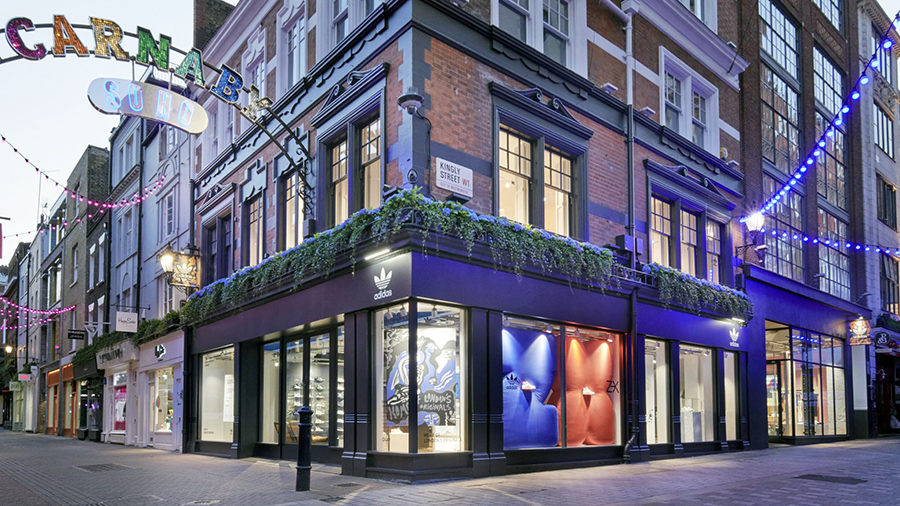Adidas is reporting that currency-neutral (c-n) revenues increased 8 percent in the first quarter of 2024, compared to the the 2023 first quarter. The better-than-expected performance was said to be driven by the “strong momentum” of the underlying Adidas business, which grew 5 percent in the period. In addition, the sale of parts of the remaining Yeezy inventory generated revenues of around €150 million during the first quarter. In euro terms, the company’s revenues grew 4 percent to €5.458 billion in the first quarter from €5.274 billion in the 2023 Q1 period, as currency fluctuations led to an unfavorable translation impact.
- Footwear revenues grew 13 percent c-n during the quarter, said to be driven by the strong brand momentum, particularly in the Originals and Football categories.
- Lifestyle revenues were up strong double digits c-n during the quarter. The company said it continued to fuel demand for its highly popular Samba, Gazelle, Spezial, and Campus franchises. While scaling the supply of these bestsellers, Adidas said it also started to extend the Terrace momentum into Running with the successful introduction of the SL72.
- In Basketball, the company launched new colorways of its Anthony Edwards and James Harden signature shoes, which Adidas suggests have quickly become popular silhouettes on and off the court.
- Performance categories reportedly benefited from the success of new product launches such as latest iterations of the iconic Predator football boot, the Agravic Speed Ultra outdoor shoe, as well as the newly introduced Supernova franchise in Running. In addition, the Adizero Adios Pro Evo 1 enabled further record-breaking performances at marathon races across the globe, driving visibility and desire for the entire Adizero product family.
- Apparel sales were up 2 percent c-n in the period. High apparel inventories at retail, particularly in the North American marketplace, reportedly still led to lower sell-in into the Wholesale channel. Although Adidas said it started to see improving sell-out trends in apparel as well – especially in the Originals category – the company acknowledged that apparel growth was still lower than growth in footwear.
- In Football (soccer), the company recorded double-digit growth in apparel in both Wholesale and DTC as a result of the successful jersey launches ahead of the UEFA Euro 2024 and the CONMEBOL Copa América.
- Accessories declined 1 percent c-n during the quarter.
Direct-to-Consumer
The Direct-to-Consumer (DTC) business was credited with driving the top-line growth for the company, growing 20 percent c-n during the quarter.
Sales in Adidas’ Own Retail stores increased 11 percent c-n for the quarter, reflecting strong double-digit c-n growth across the company’s full-price concept store fleet.
E-commerce revenues grew 34 percent c-n in Q1. While the Yeezy sales contributed to this increase, the company said revenues across its own digital platforms also increased at a double-digit rate, if adjusted for the Yeezy effect. This growth was driven by a strong double-digit increase in full-price sales as Adidas continues to focus on reducing discounting activity and improving the overall business mix on its own online platforms.
Wholesale
Wholesale sales increased 2 percent c-n, with double-digit growth in Europe, Emerging Markets, and Greater China partly offset by a decline in North America, reflecting the conservative sell-in approach in response to still elevated inventory levels in this market.
Income Statement
Gross margin was up 640 basis points to 51.2 percent of net sales, compared to 44.8 percent in the year-ago quarter. This increase was said to be driven by the company’s “much healthier inventory levels,” reduced discounting, lower sourcing costs, and a more favorable business mix. At the same time, negative currency developments weighed strongly on gross margin. While the Yeezy drop in Q1 contributed positively to the gross margin development, the company’s first quarter gross margin was also above 50 percent, if adjusted for the Yeezy impact.
Other operating expenses were up 5 percent to €2.478 billion from €2.367 billion in Q1 2023. As a percentage of sales, other operating expenses increased 50 basis points to 45.4 percent of net sales. This was reportedly driven primarily by an increase in marketing and point-of-sale expenses, which were up 9 percent to €657 million in the quarter. The increase reflects investments into the newly introduced global Adidas brand campaign ‘You Got This’, a strong brand presence at major sports events such as the Super Bowl, as well as impactful activations related to product launches like the brand-new Supernova running franchise, the latest Predator football boot and jerseys for both the Euro 2024 and Copa América.
As a percentage of sales, marketing and point-of-sale expenses increased 60 basis points to 12.0 percent of net sales.
Operating overhead expenses were up 3 percent to €1.822 billion from €1.766 billion in Q1 last year, said to be partly due to investments aimed at strengthening the company’s sales activities. As a percentage of sales, operating overhead expenses decreased 10 basis points to 33.4 percent of net sales.
Operating profit amounted to €336 million in the quarter, reflecting an operating margin of 6.2 percent of net sales, compared to €60 million, or 1.1 percent, in the 2023 Q1 period.
Net income from continuing operations amounted to €171 million, or €0.96 per share, compared to a net loss from continuing operations of €24 million, or a loss of €0.18 per share, in the year-ago period.
Regional Results
Europe region increased 14 percent c-n during the quarter driven by double-digit growth in both DTC and Wholesale as the current product is selling through very well across all channels.
Revenues in Emerging Markets and Latin America also grew at double-digit rates (17 percent and 18 percent, respectively).
Sales in Greater China were up 8 percent, with double-digit growth in Wholesale and E-commerce.
Japan/South Korea posted revenue growth of 7 percent c-n, driven by a double-digit increase in DTC.
North America
Revenues in North America declined 4 percent c-n during the quarter, reflecting a double-digit decline in the Wholesale channel as the company continued its disciplined sell-in approach. North America sales were down 5 percent in euro terms to €1.122 billion in the quarter
Gross margin jumped 1460 basis points, or 14.6 full percentage points, to 45.1 percent of sales in Q1 against a heavy promotional period in Q1 last year. Operating expenses were said to be flat year-over-year for the Q1 period.
Resulting operating profit for the quarter was €83 million, or 7.4 percent of sales, compared to a operating loss of €46 million, or negative 3.9 percent operating margin, in the 2023 Q1 period.
Balance Sheet
Inventories decreased 22 percent, or more than €1.2 billion year-over-year, to €4.427 billion at quarter-end, compared to €5.675 billion at the 2023 quarter-end, said to reflect the company’s successful initiatives to significantly reduce inventory levels.
- On a currency-neutral basis, inventories declined 20 percent compared to the prior-year period, with particularly strong improvements in North America and Greater China.
Operating working capital for the quarter was down 26 percent year-over-year to €4.745 billion. On a currency-neutral basis, operating working capital declined 23 percent. Average operating working capital as a percentage of sales decreased 2.5 percentage points to 23.5 percent compared to 26.0 percent in Q1 2023.
- The company said this reflects the inventory decrease as well as a mid-single-digit currency-neutral decline in receivables due to a more effective collection compared to the prior year. At the same time, payables increased at a double-digit currency-neutral rate, driven by business growth as well as improved payment terms.
Adjusted net borrowings at quarter-end amounted to €4.958 billion, down 25 percent, or almost €1.7 billion, from €6.630 billion at 2023 first quarter-end. This was said to mainly reflect a decline in short- and long-term borrowings as well as lease liabilities and an increase in cash and cash equivalents.
Outlook
On April 16, Adidas upgraded its full-year financial guidance as a result of the better-than-expected performance in the first quarter.
Adidas now expects currency-neutral revenues to increase at a mid- to high-single-digit rate in 2024 (previously: increase at a mid-single-digit rate). Within this guidance, it is assumed that the remaining Yeezy inventory will be sold on average at cost, resulting in sales of around €200 million throughout the remainder of the year. This corresponds to a projected total amount of Yeezy-related sales of around €350 million in FY 2024 (previously: around €250 million), of which around €150 million were generated in the first quarter.
For its underlying business, Adidas said it remains focused on scaling its successful franchises, introducing new ones, and leveraging its significantly better, broader, and deeper product range. Improved retailer relationships, more impactful marketing initiatives, and the company’s activities around major sports events are also expected to contribute to sales increases throughout 2024.
Still, unfavorable currency effects are projected to weigh significantly on the company’s profitability in 2024. They are expected to continue to adversely impact both reported revenues and gross margins in the remainder of the year.
Following the better-than-expected performance in the first quarter, the company also increased its full-year profit guidance on April 16. The company’s operating profit is now expected to reach a level of around €700 million (previously: around €500 million).
The improved bottom-line guidance includes a contribution of around €50 million from Yeezy (previously: no Yeezy contribution) related to the drop in Q1. The sale of the remaining Yeezy inventory is assumed to result in no further profit contribution during the remainder of the year.
Image courtesy Adidas
















